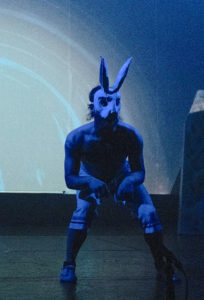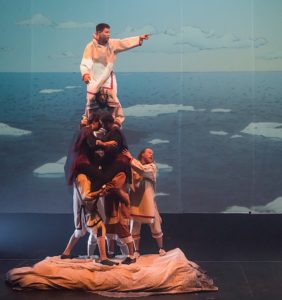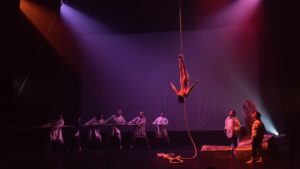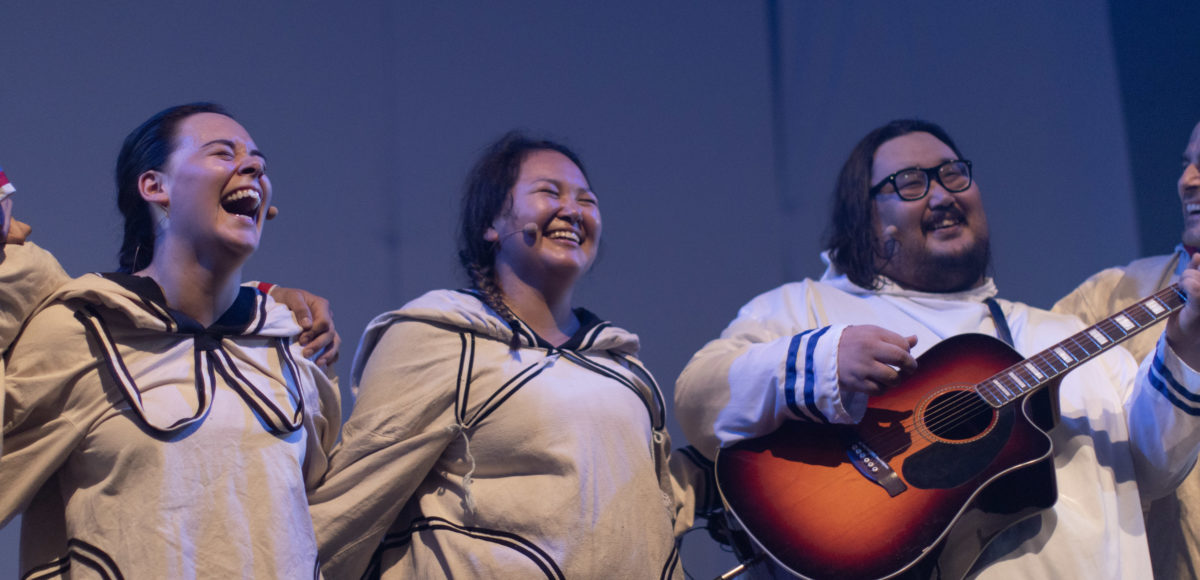The word Unikkaaqtuat means telling stories in Inuktitut. That is at the heart of a performance of the same name assembled and delivered by a talented team of artists from the North on now at the National Arts Centre as a part of the Indigenous Theatre’s first season.
As one of the co-creators Guillaume Ittukssarjuat Saladin told ARTSFILE’s Patrick Langston, the show is a chance “to feel the north without translation.” This charming show, performed mostly in Inuktitut, is an exploration of the ancient stories that are part of the Inuit’s oral tradition.
These stories are told in two ways in Unikkaaqtuat, through the actions of the performers on the stage of the Babs Asper Theatre and through the animated drawings of the Inuit artist Germaine Arnaktauyok created by Taqqut Productions of Iqaluit, which appear on a thin fabric that serves as a screen and as a piece of the northern landscape throughout the 90 minute presentation of circus, theatre, music and video. The other companies behind this production are Artcirq of Igloolik and The 7 Fingers of Montreal.
I used the word charming earlier and I don’t mean quaint. The success of Unikkaaqtuat is sophisticated and subtle. The stories it tells are elaborate, authentic and full of humour.

Chasing Rabbit in Unikkaaqtuat.
There are long dark nights in the north and the people found a way to entertain. Today the night is full of the noise of the south and the wider world. But these stories need to be told and the team behind Unikkaaqtuat makes a great case for that thinking.
The show essentially works through the vehicle of a young Inuk man confined to a hospital bed. He’s sick but no one really knows why. I think he’s sick at heart.
A relative brings in a recording of an elder telling stories and we hear him speaking while the stories play out in front of us.
In the Beginning, there was only darkness in the theatre and in the story of the same name. Hunters used to chase rabbits in the dark holding only small flames in their hands. The version told in Unikkaaqtuat is full of a sense of self-awareness and self-deprecating humour.
Many of these stories involve the creatures of the north who are equals in many ways to the humans who either hunt them or are fooled by them. There is danger too on the waters of the ocean and in the tundra.

Stuck on an ice floe and looking for safe harbour.
One fascinating scene involved a hunt for a polar bear. To escape the hunter and his dogs, the bear went into the sky, but the dogs followed. Their trails marked the night sky with the light of the stars. The players acted out the hunter, the bear (with surprising resonance to a real one) and the dogs. The Northern Lights become a place where the ancestors go after death. And the earth gives birth to a powerful child.
In the end the stories heal the young man and he leaves to go hunting.
Along the way the audience is entertained by circus moves and by representations of traditional Inuit pursuits such as the high kick. In this show the high kick was performed by launching a performer of a taut hide to strike an object far from the stage floor. There are also classic tumbling and acrobatic moves and displays of finesse on ropes and fabric suspended high off the stage.

Unikkaaqtuat is a mix of circus skills and traditional stories.
Don’t mistake this for Cirque du Soleil. This is simpler, certainly less flashy. But it is equally entertaining and all the more joyful because it is honest and real.
Don’t be put off by the fact that the language may be unknown to you. I found that actually freed me to just enjoy what I saw uninhibited by expectations.
Unikkaaqtuat is in the Babs Asper Theatre at the NAC until Jan. 12. For more nac-cna.ca.







